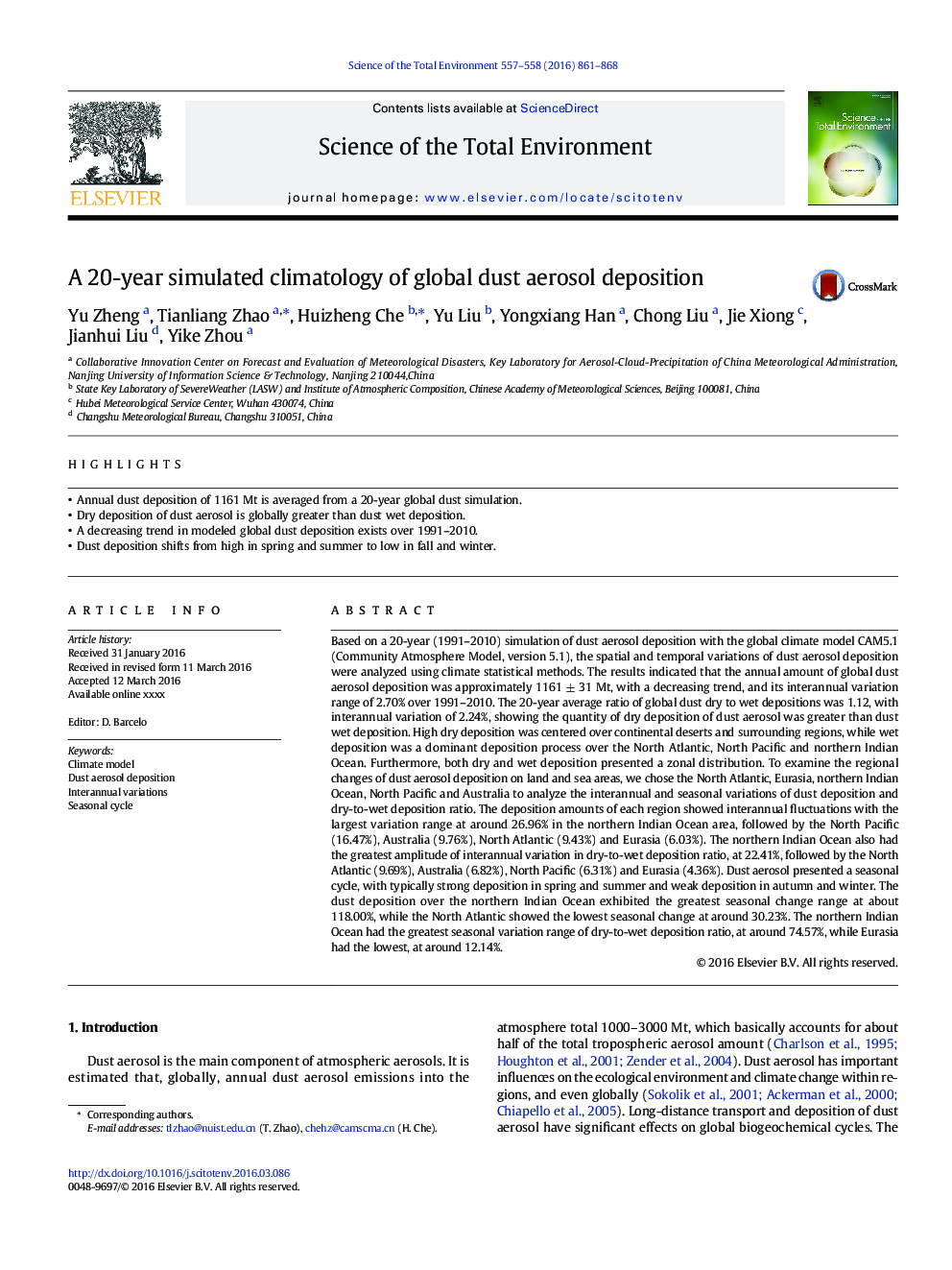| کد مقاله | کد نشریه | سال انتشار | مقاله انگلیسی | نسخه تمام متن |
|---|---|---|---|---|
| 6322681 | 1619729 | 2016 | 8 صفحه PDF | دانلود رایگان |
عنوان انگلیسی مقاله ISI
A 20-year simulated climatology of global dust aerosol deposition
ترجمه فارسی عنوان
یک کوهنوردی شبیه سازی 20 ساله رسوب گرد و غبار آلودگی جهانی
دانلود مقاله + سفارش ترجمه
دانلود مقاله ISI انگلیسی
رایگان برای ایرانیان
کلمات کلیدی
مدل آب و هوا، رسوب آئروسل گرد و غبار، تغییرات بین سالیانه، چرخه فصلی،
موضوعات مرتبط
علوم زیستی و بیوفناوری
علوم محیط زیست
شیمی زیست محیطی
چکیده انگلیسی
Based on a 20-year (1991-2010) simulation of dust aerosol deposition with the global climate model CAM5.1 (Community Atmosphere Model, version 5.1), the spatial and temporal variations of dust aerosol deposition were analyzed using climate statistical methods. The results indicated that the annual amount of global dust aerosol deposition was approximately 1161 ± 31 Mt, with a decreasing trend, and its interannual variation range of 2.70% over 1991-2010. The 20-year average ratio of global dust dry to wet depositions was 1.12, with interannual variation of 2.24%, showing the quantity of dry deposition of dust aerosol was greater than dust wet deposition. High dry deposition was centered over continental deserts and surrounding regions, while wet deposition was a dominant deposition process over the North Atlantic, North Pacific and northern Indian Ocean. Furthermore, both dry and wet deposition presented a zonal distribution. To examine the regional changes of dust aerosol deposition on land and sea areas, we chose the North Atlantic, Eurasia, northern Indian Ocean, North Pacific and Australia to analyze the interannual and seasonal variations of dust deposition and dry-to-wet deposition ratio. The deposition amounts of each region showed interannual fluctuations with the largest variation range at around 26.96% in the northern Indian Ocean area, followed by the North Pacific (16.47%), Australia (9.76%), North Atlantic (9.43%) and Eurasia (6.03%). The northern Indian Ocean also had the greatest amplitude of interannual variation in dry-to-wet deposition ratio, at 22.41%, followed by the North Atlantic (9.69%), Australia (6.82%), North Pacific (6.31%) and Eurasia (4.36%). Dust aerosol presented a seasonal cycle, with typically strong deposition in spring and summer and weak deposition in autumn and winter. The dust deposition over the northern Indian Ocean exhibited the greatest seasonal change range at about 118.00%, while the North Atlantic showed the lowest seasonal change at around 30.23%. The northern Indian Ocean had the greatest seasonal variation range of dry-to-wet deposition ratio, at around 74.57%, while Eurasia had the lowest, at around 12.14%.
ناشر
Database: Elsevier - ScienceDirect (ساینس دایرکت)
Journal: Science of The Total Environment - Volumes 557â558, 1 July 2016, Pages 861-868
Journal: Science of The Total Environment - Volumes 557â558, 1 July 2016, Pages 861-868
نویسندگان
Yu Zheng, Tianliang Zhao, Huizheng Che, Yu Liu, Yongxiang Han, Chong Liu, Jie Xiong, Jianhui Liu, Yike Zhou,
